Adam Miller has taken on a very ambitious task for himself: the creation of mythological and allegorical scenes that pose human figures in invented settings. The first phase of his career after art school -- painting large scale murals often inspired by Tiepolo -- came to an end after he realized that most of his clients simply wanted decorative backdrops. In his current easel paintings Miller has demonstrated an ambitious desire to re-visit and re-examinine mythological archetypes as they cope with challenging and contemporary situations. Miller has just turned 34 and his precocious transcendence of the norms of classical realism makes him an exciting and dynamic figure worth watching.
I recently interviewed Adam Miller and asked him about his work and his values.
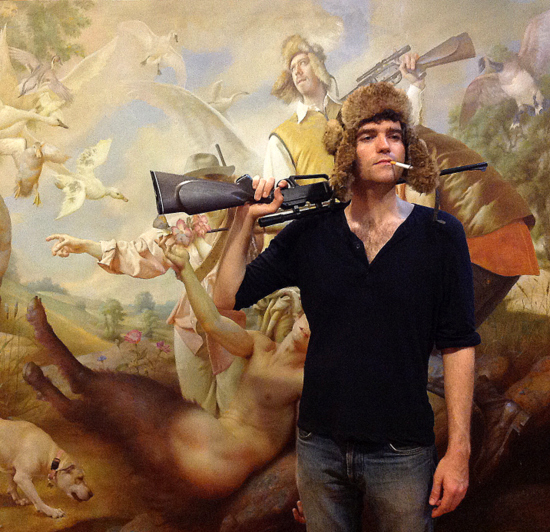
Adam Miller
John Seed Interviews Adam Miller
When did you first know that you were an artist?
I always drew and was lucky to have plenty of art materials around. My parents were involved in theater and my mother also painted murals so it seemed very natural to spend time creating and drawing. At first I was convinced I would be a comic artist, illustrator and writer. I would practice perspective, anatomy, and write stories.
At around 14 I discovered Michelangelo, Titian, Raphael and later Diego Rivera and Jose Maria Sert. I saw that they were using all of the same pictorial tools and devices I was interested in from comics but in a large simple language. They did not speak about individuals as contemporary fine artists tended to do but about the classical idea of the individual in the context of society. They were more interested in elucidating character through action in relation to other people who would react. As someone interested in writing and narrative this made sense to me as a way to build a pictorial language capable of expressing more than just a mood Which is what most modern figure painting seemed to be trying to do.
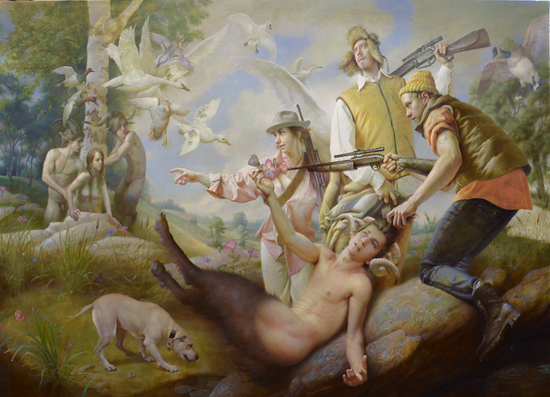
Adam Miller, "Twilight in Arcadia," oil on canvas, 100 x 72 inches
In a recent interview you spoke about being a Humanist, and about disliking categories and systems. Tell me more about those values and how they affect your artistic practice.
From Voltaire and Swift to Kurt Vonnegut and George Carlin The Humanist role has been to say I think we can do better and to oppose authoritarian ways of limiting thought. As a way to explore this process I have become very interested in the idea of the transference. The way human beings have built in powerful archetypes and will transfer those archetypes onto an external object or idea enlarging that person into a celebrity or that idea into a dogma or religion.
Currently we do this with science. It has such power and I see people constantly taking it out of its realm and boundaries and inventing pseudo science in areas where we simply are unable to seriously apply scientific method. This can lead to absurd conclusions. One of the areas I observe this happening is in art.
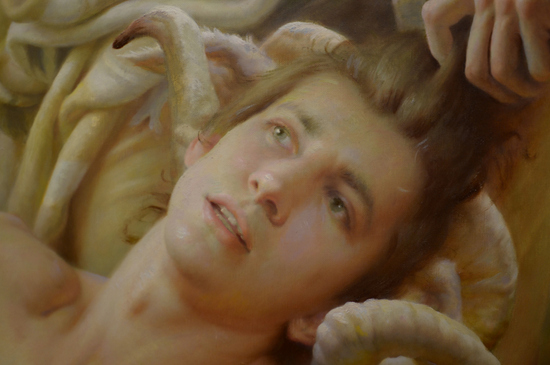
Detail of "Twilight in Arcadia."
I see a lot of artists and critics building elaborate theories and making sweeping statements about what art should be in it's narrow and imaginary historical context. these ideas masquerade as genuine intellectual discovery but are basically empty sophistry and agenda pushing. It reminds me of the credit default swaps that were so effective because they were supposedly based on such profound almost alchemical mathematics from the scientific priesthood that they were unquestionable by mere mortals and yet at the heart they were essentially empty hiding behind a wall of mystique and jargon.
I think as a society we need to push the occupy wall street model where people start calling out bullshit when we see it or we will most likely slip into a new form of feudalism where citizens give up their rights not by becoming repressed or enslaved but by losing confidence in their ability to shape their own society.
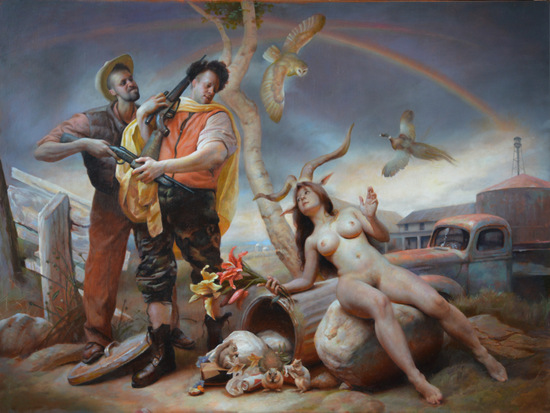
Adam Miller, "Apparition," oil on canvas, 30 x 40 inches
You have told me that you admire representational artists who turn away from marketable categories of work such as portraits and still lifes. In what ways are you trying to move away from known and accepted genres?
I think there is so much more that figure painting can do than what is commonly being represented and shown. I am always trying to push the boundaries of stories and scale in my work. Classical figure painting is by it's nature a time consuming and slow way of painting which makes the challenge of doing the more ambitious paintings even greater but I think it is important to make those paintings that tell bigger stories about life and culture. I was never interested in just making pretty pictures. I also think the market for realism is very tilted toward small easy to hang pieces. Since seeing the works of artists such as Michelangelo and Tiepolo this has never been very satisfying for me.
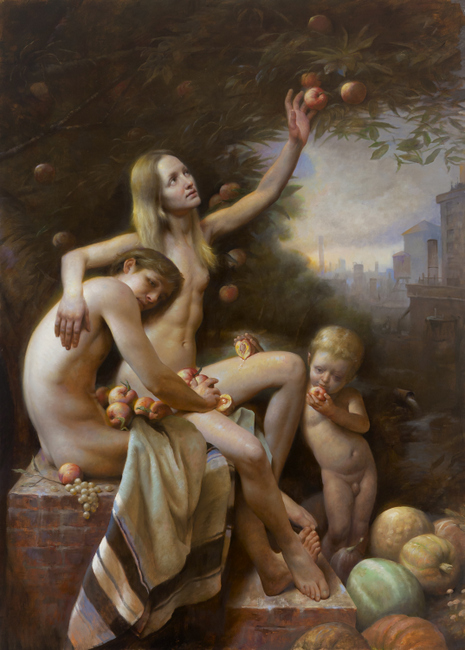
Adam Miller, "Oasis," oil on canvas, 74 x 53 inches
You define yourself as a contemporary mythologist. Tell me how you generate that sense of myth in your work.
I view the source of myth as going back to the very beginnings of human culture and representing a continuity that still exists in society's big stories. I try to find the common archetypes of character and also explore the popular mythology of today as a new source of concepts and inspiration.
My current series is based on hunters and I took inspiration form the idea of Artemis as the huntress of Greek mythology. She lived to hunt and represents that part of the human genetic make up. She was not cruel but simply unforgiving as nature itself is. I love that art can make these sub conscious forces conscious again. Whether we like it or not we are still dominated by these archetypes.
When we are mowing down trees or farming animals in concentration camp conditions to feed our never ending hunger we are still acting out the same drama our distant ancestors did when they took life to feed their own. Beyond our relationship to nature we are doing the same to our culture. The inefficiencies must be cleared away. The beautiful and artistic is being ruthlessly stripped from our cities and lives in favor of efficient freeways and shopping malls so we can more easily feed a never-ending hunger.
As artists I don't think we need to be activists we simply need to look as clearly as we can at the world with a larger reference to human history and find a clear visual image that can bring that elemental force into the consciousness of the viewer. It is when these forces are not appreciated for their attractive power as well as their danger that we get into trouble.
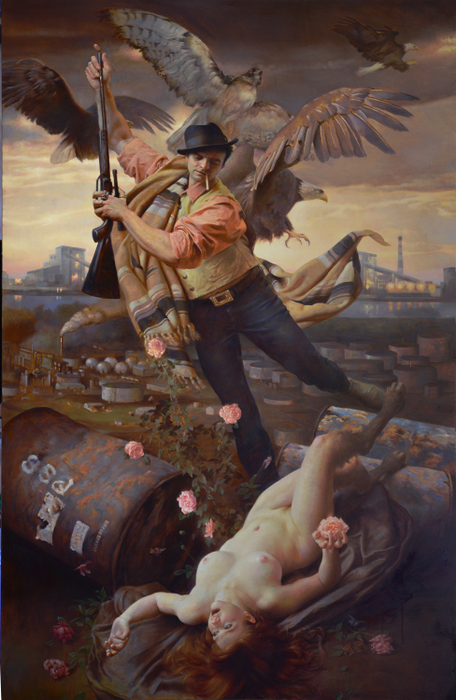
Adam Miller, "The Roses Never Bloomed so Red," oil on canvas, 96 x 60 inches
Who are some artists -- living and dead -- that you admire?
I like artists who have mastered their craft. In that I include composition storytelling, technique. Odd Nerdrum has had a big influence on me. His fearlessness to paint with all of his heart to push himself to his limits and to stay true to his vision wherever that led has led to the creation of a great body of work.
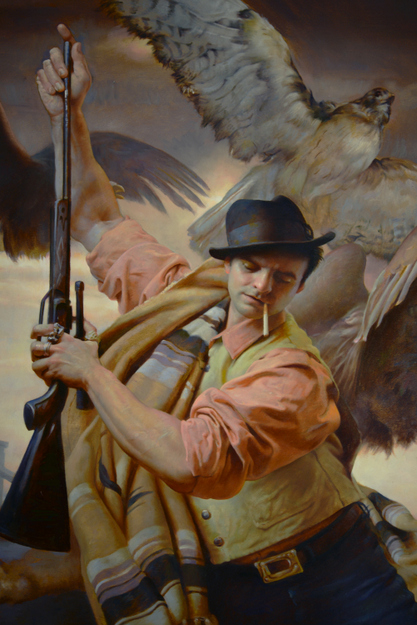
Detail of "The Roses Never Bloomed so Red"
I also admire Vincent Desiderio, Julie Heffernan, Steven Assael and Nicola Verlato as well as my peers among younger painters who are carving out a vision and perfecting their craft and language by long hours in the studio. I think there is a great movement of representational painters coming into their full blossom right now that will surprise alot of people soon and will be hard to ignore.
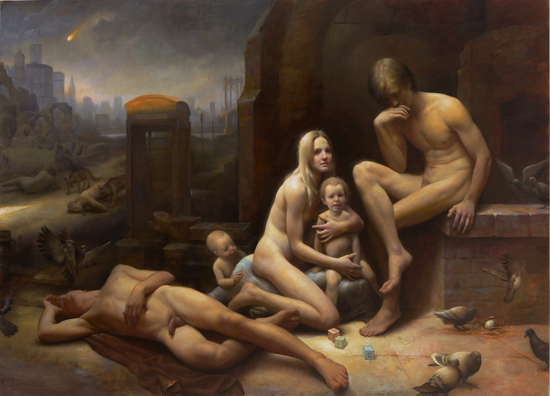
Adam Miller, "Among the Ruins," oil on canvas, 79 x 57 inches
Your work seems to have recently changed in mood and coloration. Why is that happening?
I am looking at every series I make right now as one in a series of concentric circles building towards a center. It is a late medieval structure like the one used in Chaucer's Canterbury tales or Boccaccio's Decameron. As I continue I will keep shifting each new series in the direction of a different palette and compositional style. I like the idea of astronomical forms because it reflects the idea that at the center is a source of life and creativity and different states of existence can be closer to that source. As an individual I think we are all searching for that source for ourselves.
The sun represents the energetic mover or what you could call love in the solar system, that thing that generates the order and life we see around us and of which we are both an individual part and a piece of the whole. Among the Ruins from 2011 was a very remote planet where only the smallest glimmer of the suns radiance is felt. The hunters or the moon represent the place where love is present but the animal need to survive is very strong and overwhelms compassion. The creatures that are being hunted are ethereal mythic creatures of the imagination. They are the delicate thoughts and sentiments that can be so hard to hold on to in the face of everyday reality.
Note: Adam Miller's painting "The Roses Never Bloomed so Red" will be on display at the LA Municipal Art Gallery on October 12th and 13th as part of "Beyond Eden."
I recently interviewed Adam Miller and asked him about his work and his values.

When did you first know that you were an artist?
I always drew and was lucky to have plenty of art materials around. My parents were involved in theater and my mother also painted murals so it seemed very natural to spend time creating and drawing. At first I was convinced I would be a comic artist, illustrator and writer. I would practice perspective, anatomy, and write stories.
At around 14 I discovered Michelangelo, Titian, Raphael and later Diego Rivera and Jose Maria Sert. I saw that they were using all of the same pictorial tools and devices I was interested in from comics but in a large simple language. They did not speak about individuals as contemporary fine artists tended to do but about the classical idea of the individual in the context of society. They were more interested in elucidating character through action in relation to other people who would react. As someone interested in writing and narrative this made sense to me as a way to build a pictorial language capable of expressing more than just a mood Which is what most modern figure painting seemed to be trying to do.

From Voltaire and Swift to Kurt Vonnegut and George Carlin The Humanist role has been to say I think we can do better and to oppose authoritarian ways of limiting thought. As a way to explore this process I have become very interested in the idea of the transference. The way human beings have built in powerful archetypes and will transfer those archetypes onto an external object or idea enlarging that person into a celebrity or that idea into a dogma or religion.
Currently we do this with science. It has such power and I see people constantly taking it out of its realm and boundaries and inventing pseudo science in areas where we simply are unable to seriously apply scientific method. This can lead to absurd conclusions. One of the areas I observe this happening is in art.

I see a lot of artists and critics building elaborate theories and making sweeping statements about what art should be in it's narrow and imaginary historical context. these ideas masquerade as genuine intellectual discovery but are basically empty sophistry and agenda pushing. It reminds me of the credit default swaps that were so effective because they were supposedly based on such profound almost alchemical mathematics from the scientific priesthood that they were unquestionable by mere mortals and yet at the heart they were essentially empty hiding behind a wall of mystique and jargon.
I think as a society we need to push the occupy wall street model where people start calling out bullshit when we see it or we will most likely slip into a new form of feudalism where citizens give up their rights not by becoming repressed or enslaved but by losing confidence in their ability to shape their own society.

I think there is so much more that figure painting can do than what is commonly being represented and shown. I am always trying to push the boundaries of stories and scale in my work. Classical figure painting is by it's nature a time consuming and slow way of painting which makes the challenge of doing the more ambitious paintings even greater but I think it is important to make those paintings that tell bigger stories about life and culture. I was never interested in just making pretty pictures. I also think the market for realism is very tilted toward small easy to hang pieces. Since seeing the works of artists such as Michelangelo and Tiepolo this has never been very satisfying for me.

I view the source of myth as going back to the very beginnings of human culture and representing a continuity that still exists in society's big stories. I try to find the common archetypes of character and also explore the popular mythology of today as a new source of concepts and inspiration.
My current series is based on hunters and I took inspiration form the idea of Artemis as the huntress of Greek mythology. She lived to hunt and represents that part of the human genetic make up. She was not cruel but simply unforgiving as nature itself is. I love that art can make these sub conscious forces conscious again. Whether we like it or not we are still dominated by these archetypes.
When we are mowing down trees or farming animals in concentration camp conditions to feed our never ending hunger we are still acting out the same drama our distant ancestors did when they took life to feed their own. Beyond our relationship to nature we are doing the same to our culture. The inefficiencies must be cleared away. The beautiful and artistic is being ruthlessly stripped from our cities and lives in favor of efficient freeways and shopping malls so we can more easily feed a never-ending hunger.
As artists I don't think we need to be activists we simply need to look as clearly as we can at the world with a larger reference to human history and find a clear visual image that can bring that elemental force into the consciousness of the viewer. It is when these forces are not appreciated for their attractive power as well as their danger that we get into trouble.

I like artists who have mastered their craft. In that I include composition storytelling, technique. Odd Nerdrum has had a big influence on me. His fearlessness to paint with all of his heart to push himself to his limits and to stay true to his vision wherever that led has led to the creation of a great body of work.


I am looking at every series I make right now as one in a series of concentric circles building towards a center. It is a late medieval structure like the one used in Chaucer's Canterbury tales or Boccaccio's Decameron. As I continue I will keep shifting each new series in the direction of a different palette and compositional style. I like the idea of astronomical forms because it reflects the idea that at the center is a source of life and creativity and different states of existence can be closer to that source. As an individual I think we are all searching for that source for ourselves.
Note: Adam Miller's painting "The Roses Never Bloomed so Red" will be on display at the LA Municipal Art Gallery on October 12th and 13th as part of "Beyond Eden."
